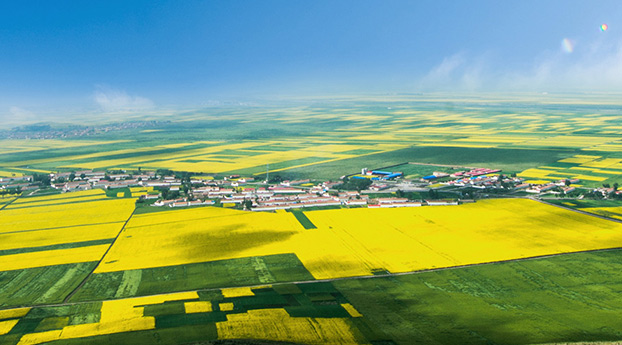Efficient forward modeling of GPR based on Hybrid ADI-FDTD Subgrid technology and its application in hydraulic engineering
Release time:2015-01-28 Views:79
【作者】 吴奇;
【导师】 汤井田;
【作者基本信息】 中南大学 , 地球探测与信息技术, 2014, 博士
【摘要】 摘要:探地雷达是利用高频电磁波在地下介质中的反射、绕射等传播特性来探测地下结构和特性的重要浅层地球物理方法,已广泛的应用在工程勘察与无损检测的众多领域,表现出强劲的生命力和广阔的应用前景。目前,GPR资料解译仍主要依靠人工判断与经验解译,以定性为主,易产生虚警及误解释,与GPR工程勘探的高精度和高分辨率客观要求相比,仍存在不少差距。因此,开展雷达波的正演模拟研究,使得一些复杂地质现象能够计算出正演雷达图谱,进而能够了解复杂地质体的雷达图像回波特征,对提高数据解译水平仍具有重要意义。此外,GPR正演也是反演的核心引擎,正演速度的快慢决定了反演算法的效率,它与反演相得益彰,互相促进。因此,深入开展高效、高精度正演算法的研究,有助于反演技术的提升。本文开展了FDTD、ADI-FDTD、混合ADI-FDTD亚网格技术的GPR正演算法研究;并在作者多年从事水利工程GPR应用的基础上,改进了GPR水上作业技术、总结了水库淤积探测的一些重要技术措施和创新,可为GPR技术在水利工程中的应用推广提供科学依据。该研究是在深圳水务专项资金(深水务[2011]200)的资助下进行的,主要开展了以下工作:(1)基于Maxwell方程组,结合媒质的本构关系及Yee氏网格,导出了二、三维FDTD法频散与非频散介质雷达波正演的差分方程、CFL数值稳定性条件和数值频散关系表达式,为应用FDTD算法开展高精度GPR正演计算打下理论基础。(2)阐述了二阶近似的Mur边界条件、UPML、CFS-PML边界条件的原理,开展了UPML与CFS-PML边界的差分公式推导及参数设置讨论。应用均匀介质中GPR波场传播快照,对比了大区域无截断、截断处没有加载边界条件、加载3种不同边界条件5种情况下的边界处反射波的强弱,试图说明UPML、CFS-PML边界条件的吸收效果。为了进一步对比UPML与CFS-PML吸收效果,设置了双层介质狭长模型,试图通过波场快照与全局反射误差来证明CFS-PML对隐失波、低频波、掠角波的吸收效果。(3)基于Matlab平台与C++语言编制了GPR二维、三维FDTD正演程序,应用具有解析解的三层模型验证了程序的正确性及算法的有效性;然后,将该程序应用于介电常数、电导率与雷达波传播特性之间,异常体埋深、雷达频率与雷达分辨率之间的关系分析中,开展了有效的实例验证。(4)设计了1个复杂二维GPR地电模型、1个含有3个异常体的典型三维雷达地电模型,应用二、三维FDTD雷达模拟程序进行了正演计算,得到了二维雷达剖面图及波场快照、三维剖视图与切片图,系统地反映了异常体的回波特征,加深了对雷达反射剖面的认识,有助于了解雷达波在空间的传播特性。(5)总结了ADI-FDTD算法的特点:它将FDTD算法中一个时间步迭代过程在ADI-FDTD算法中被两个子时间步的迭代所取代,两个子时间步分别交替取隐式与显式。开展了二维TM波的ADI-FDTD算法的稳定性证明与数值色散关系分析,试图证明ADI-FDTD具有无条件稳定的特点,可选取较大的时间步长;推导了二、三维GPR正演的ADI-FDTD的差分迭代计算公式。(6)深化了基于混合ADI-FDTD亚网格技术GPR正演算法,着重探讨了粗细网格之间场值的过渡与衔接、场值的交换与更新等重要内容,指出算法的核心思想为:在物性参数变化剧烈局部区域采用细网格剖分ADI-FDTD计算,其他的区域采用常规FDTD计算,因为ADI-FDTD突破了CFL条件的约束,可选取与粗网格一致的大时间步长,计算中只需考虑空间不一致网格的场值交换问题,时间步长一致完全不用考虑,编程计算简便,能有效地提高计算效率。(7)结合GSSI公司的Radan后处理软件,编制了基于混合ADI-FDTD亚网格算法的探地雷达2D与3D正演模拟及显示程序,将该程序对背景介质为Deybe复介电常数的二维矩状异常体模型、频散介质及非频散介质构成的横向不均匀二维组合模型、三维雷达地电模型进行了正演,将它的正演结果与粗网格FDTD及细网格FDTD算法计算结果进行了对比,试图证明ADI-FDTD算法在精确性与时效性之间能够取得满意的平衡,为高精度、高效率雷达反演算法研究打下基础。(8)将GPR正演计算应用于水利工程实践中,建立了7种不同构造的典型河道淤泥厚度模型,应用FDTD对这些模型开展了正演模拟计算,得到相应的二维雷达反射剖面图,通过对比分析模型图与雷达正演模拟剖面图,找出目的物边界雷达图谱特征,指导实际雷达探测图谱的解释,证明探地雷达方法在河道淤积厚度、抛石范围探测中的有效性。(9)研究了GPR水上工作技术,通过改进天线耦合方式,最大限度地减少了天线与水面之间的反射能量损失、反射干扰,提高了探地雷达探测深度,增大了探地雷达水上作业使用范围,有效地解决了水利工程中水库、河道淤泥探测难题,提高了探测精度与效率,为水利工程安全隐患诊断提供更充分的依据。通过以上仔细认真的研究工作得出了如下研究结论:(1)证明了UPML、CFS-PML边界条件具有较好的吸收效果,CFS-PML对隐失波、低频波、掠角波能更高效地吸收。(2)基于Matlab平台与C++语言编制了GRP二维、三维FDTD正演程序,编制了基于混合ADI-FDTD亚网格算法的探地雷达2D与3D正演模拟及显示程序。(3)证明了ADI-FDTD具有无条件稳定的特点,可选取较大的时间步长;推导出了二、三维GPR正演的ADI-FDTD的差分迭代计算公式。(4)证明了在物性参数变化剧烈局部区域采用细网格剖分ADI-FDTD计算,其他的区域采用常规FDTD计算的可行性;论证了ADI-FDTD算法在精确性与时效性之间能够取得满意的平衡,这就为提高计算效率,为高精度、高效率雷达反演算法研究打下基础。(5)利用以上研究成果对7种不同构造的典型河道淤积厚度模型开展了正演模拟计算,得到相应的二维雷达反射剖面图,通过对比分析模型图与雷达正演模拟剖面图,找出了各类目的物的边界雷达图谱特征,这就可以对工程实际雷达探测图谱的解释作出指导,减少了误判,提高了资料解释进度。(6)改进了GPR水上作业天线耦合方式,减少了天线与水面之间的反射能量损失、反射干扰,提高了探地雷达探测深度、精度,扩大了探地雷达水上作业范围(如大江大河水下覆盖层厚度探测等难题就可能变得很容易解决了)。
【Abstract】 ABSTRACT:Ground penetrating radar (GPR) is an important kind of shallow geophysical methods which uses reflection, diffraction and other propagation characteristics of high frequency electromagnetic wave to detect the structure and characteristics of the underground medium, it has been widely used in many areas of engineering survey and nondestructive testing, and showing a strong vitality and broad application prospects.At present, GPR data interpretation is still qualitative and mainly rely on manual judgment and experiences, which is liable likely to produce a false interpretation, there are still many gaps between the high requirement of GPR resolution in engineering exploration area. Therefore, study on GPR forward modeling and the GPR reflection image characteristics of complex geological target are of great significance to improve the GPR data interpretation level. Moreover, GPR forward modeling is the basis of GPR inversion, the speed of forward modeling determines the efficiency of the inversion algorithm, high efficiency and precision of forward modeling algorithm helps to improve the inversion interpretation techniques. Meanwhile, with the characteristics of easy to carry out, rapid data-sampling, large amount of sampling and high precision, this method gains great popularity for the geophysical workers, but with the disadvantage of large energy loss, shallow detecting depth, GPR method makes some major rivers can’t use this method in geophysical exploration. Therefore, improving the GPR techniques and detecting depth in waterborne area is of great practical significance.The thesis carried out a series of GPR forward modeling research, which including Finite Difference Time Domain (FDTD), Alternating Direction Implicit Finite Difference Time Domain (ADI-FDTD) and Mixed ADI-FDTD sub-grid technology. Combined with the many years engaged in hydraulic engineering of GPR application, the author improved the GPR techniques in waterborne area and summarized some important technical measures about reservoir sedimentation detection with GPR, this will provide a scientific basis for the promotion and application of GPR technology in hydraulic engineering. The paper was funded by a joint support of the National Natural Science Fund (41074085), the Special Foundation for Shenzhen Water Utilities(2011-200), the main contributions of the thesis are listed as follows:(1) Based on the Maxwell’s equations, the constitutive relations of medium and Yee’s grid, the two-dimensional and three-dimensional GPR modeling FDTD equation was derived both in dispersive and non-dispersive medium, as well as the Courant-Friedrich-Levy (CFL) numerical stability condition and the formula of numerical dispersion, which will lay a theoretical foundation for the application of FDTD algorithm in high resolution GPR forward calculation.(2) Elaborated the principle of second order approximate Mur Boundary Condition, the Uniaxial Perfect Match Layer (UPML) and the Complex-Frequency Shifted Perfect Match Layer (CFS-PML) Boundary Condition, the thesis derived and discussed the difference formula of these Boundary Conditions. Using the snapshots of GPR wave field propagation in homogeneous medium, compared the large area without truncation, with no boundary conditions added at truncation, three different boundary conditions of5cases of the reflected wave strength at the border, which is attempt to show the better absorption effect of the UPML and the CFS-PML boundary condition. In order to compare the UPML with the CFS-PML, a slim model with double-layer medium was set, from the perspective of the wave snapshots and the global reflection error, which is attempt to show that the CFS-PML is more efficiently in dealing with evanescent wave, low frequency wave and grazing wave absorption.(3) The two-dimensional and three-dimensional FDTD forward modeling program of GPR was compiled with the tool of Matlab and C++, and using a three-layer model with analytic solution to validate the correctness of the program and the effectiveness of the algorithm, then the program is applied to some effective examples,in which the relationship between the dielectric constant, electrical conductivity and propagation,the relationship between the depth of target, the frequency of GPR and the resolution of GPR both has been systematically analysed.(4) The thesis designed a two-dimensional GPR complex geoelectric model, a three-dimensional GPR typical geoelectric model with three targets added, both two-dimensional and three-dimensional forward modeling were carried out with the compiled program, from the obtained results such as section, wave snapshots and three dimensional figure, it systematically reflected the echo characteristics of target, deepened the understanding of GPR reflection section, which helps to understand the propagation characteristics of GPR in medium.(5) Summarizes the characteristics of ADI-FDTD algorithm:one time step iteration in FDTD algorithm is replaced by two sub-time steps iteration in ADI-FDTD algorithm, and two sub-time steps is alternately implicit and explicit. Carried out the stability and numerical dispersion relationship analysis of ADI-FDTD algorithm with TM wave, which is attempting to prove that the ADI-FDTD is unconditional stable even though a larger time step was chosen. Meanwhile, two and three dimensional ADI-FDTD GPR modeling iterative calculation formula was deduced.(6) The paper proposed a GPR forward algorithm which based on Mixed ADI-FDTD grid technology, and emphatically discusses the transition and cohesion, the exchange and update of the field value between coarse grid and fine grid, etc. Relying on the advantages of ADI-FDTD computation efficiency, not bounded by CFL condition, with simple programming process, the core of the ADI-FDTD algorithm is that in case of physical parameters change dramatically area by adopting the ADI-FDTD with fine grid mesh, while,other areas by adopting the conventional FDTD algorithm.(7) Combined with GSSI company processing software Radan, the paper compiled a2D and3D forward modeling program of GPR based on Mixed ADI-FDTD grid algorithm, using this program to lead a series of forward modeling, the model including two-dimensional and three-dimensional geoelectric model with lateral heterogeneous medium, compared with the conventional FDTD coarse grid and fine grid calculation results, which is attempt to show that ADI-FDTD algorithm is a method of satisfactory balance between accuracy and timeliness, which lays the foundation for GPR inversion research with high precision and high efficiency.(8) The ADI-FDTD algorithm of GPR forward was applied to seven different typical river sedimentation thickness model in hydraulic engineering, compared with the geoelectric model and forward simulation results, to find the radar characteristics of object boundary, to guide the interpretation of the GPR section, and aim of proving that the GPR method is feasible in the river sedimentation thickness detect application.(9) The thesis studied the techniques of waterborne GPR, the new techniques improved the detection depth and detecting accuracy, increased the application of GPR in hydraulic engineering by means of improving the antenna coupling reaction, which is aimed at minimizing the reflection energy attenuation and interference at surface of waterborne, all of which will effectively solve the sedimentation detection problem in the reservoir, river and other hydraulic area detection, and provide a more sufficient basis for the hidden trouble diagnosis in the hydraulic engineering.Through the earnestly studies, the research conclusions are as follows:(1) Proved the better absorption effect of the UPML and the CFS-PML boundary condition. Meanwhile, demonstrated that the CFS-PML is more efficiently in dealing with evanescent wave, low frequency wave and grazing wave absorption.(2) The two-dimensional and three-dimensional FDTD forward modeling program of GPR was compiled with the tool of Matlab and C++, and the2-D&3-D Mixed ADI-FDTD sub-grid algorithmic of GPR forward modeling was compiled.(3) Proved that the ADI-FDTD is unconditional stable even though a larger time step was chosen. And2-D&3-D ADI-FDTD GPR modeling iterative calculation formula was deduced.(4) Demonstrated that in case of physical parameters change dramatically area by adopting the ADI-FDTD with fine grid mesh, while,other areas by adopting the conventional FDTD algorithm, and proved that the ADI-FDTD algorithm is a method of satisfactory balance between accuracy and timeliness, which lays the foundation for GPR inversion research with high precision and high efficiency.(5) Carried out a series of forward modeling in seven different typical river sedimentation thickness model with the research result above, compared with the geoelectric model and forward simulation results, to find the radar characteristics of object boundary, to guide the interpretation of the GPR section, as well as to reduce the misjudgment, and improves the interpretation process.(6) With the improved antenna coupling reaction in waterborne GPR, the techniques minimizied the reflection energy attenuation and interference at surface of waterborne, and improved both the detection depth and detecting accuracy, which expanded the application range of waterborne GPR in water operation area(such as underwater coating thickness detection of large rivers problem can become easily solved).
【关键词】 探地雷达; 时域有限差分法(FDTD); 交替方向隐式时域有限差分法(ADI-FDTD); 混合ADI-FDTD亚网格; 单轴各向异性完全匹配层边界条件(UPML); 复频移完全匹配层边界条件(CFS-PM L); 正演模拟; 天线耦合方式;
【Key words】 Ground penetrating radar(GPR); Finite Difference TimeDomain(FDTD); Alternating Direction Implicit Finite Difference TimeDomain(ADI-FDTD); Mixed ADI-FDTD grid; Uniaxial Perfect MatchLayer(UPML); Complex Frequency Shifted Perfect Match Layer (CFS-PML); Forward Modeling; Antenna Coupling Reaction;

















